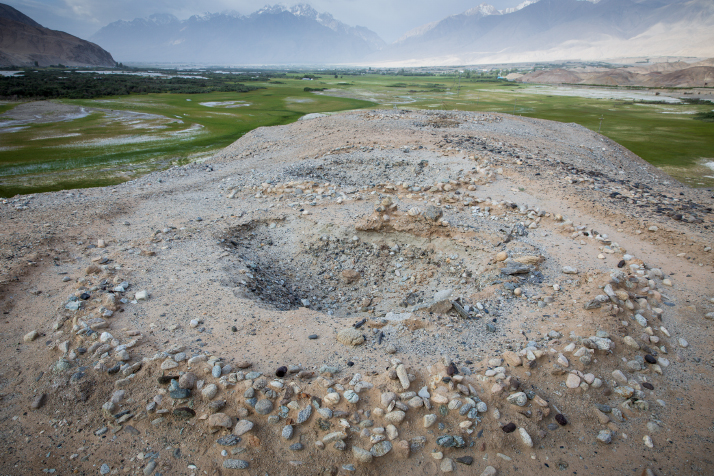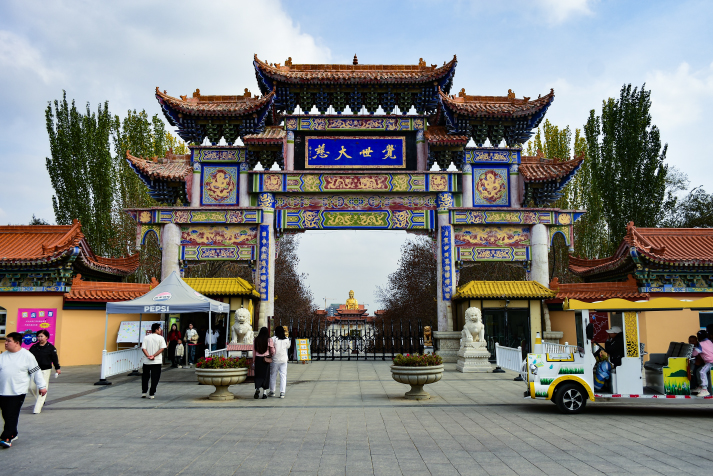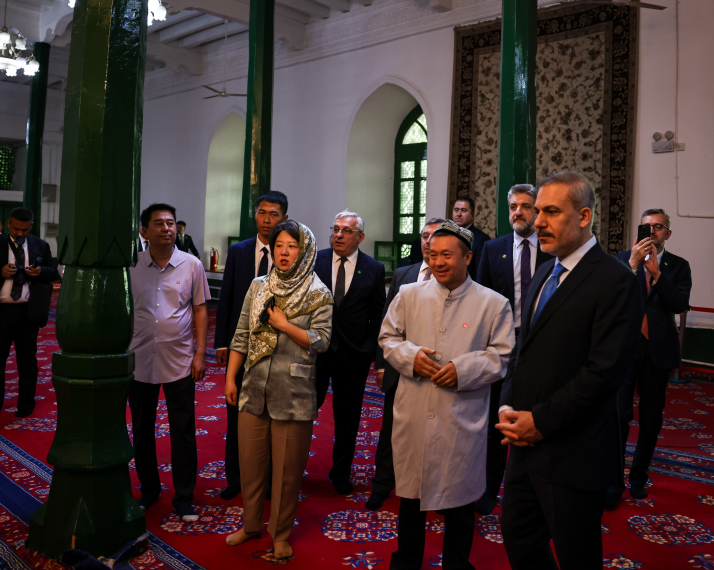| Xinjiang Today |
| What do the development and integration of religions bring to Xinjiang? | |
|
|
 A tomb complex in Tashikuergan (Taxkorgan or Tashkurgan) Tajik Autonomous County, Kashi Prefecture, contains remains of Zoroastrianism, which worships fire, dating back around 2,500 years. The bright and dark stone stripes are typical symbols of Zoroastrianism as they represent the rays of sun or fire (VCG)
Located in northwest China and the hinterland of the Eurasian continent, Xinjiang has been an important channel and hub for economic and cultural exchanges between East and West since ancient times. It has also been a center for the spread, convergence, and integration of multiple civilizations and religions.
As a region where multiple ethnic groups live together and diverse religions coexist, the pattern of coexistence of multiple religions, with one or two predominant, is a historical feature of Xinjiang's religious environment.  The Hongguangshan Giant Buddha Temple in Urumqi (VCG)
How did the coexistence of multiple religions come about? All three routes of the ancient Silk Road traverse Xinjiang. In the era when the Silk Road flourished, Xinjiang had quite frequent exchanges with the Central Plains of China, the Mongolian Plateau, Siberia, Central Asia, the Indian subcontinent, and even West Asia and Europe. It is particularly worth mentioning that Xinjiang had the closest ties with the Central Plains of China. Xinjiang's geography and natural environment have determined its status as the center of major civilizations between East and West, serving as a primary avenue for economic exchanges as well as cultural dissemination, exchange and integration among various civilization centers. Almost all major world religions have gathered here. Even so, the formation and evolution of the coexistence of multiple religions in Xinjiang have come a long way. Before the introduction of religions from other regions, primitive religion and Shamanism were widespread in Xinjiang. Around the fourth century B.C., Zoroastrianism was introduced into Xinjiang. About the first century B.C., Buddhism reached Xinjiang and was widely practiced by the nobility and the common people. Gradually, Buddhism replaced Shamanism and Zoroastrianism as the dominant religion. From the fourth century to the seventh century, Taoism, Nestorianism and Manichaeism were introduced into Xinjiang, forming a pattern of coexistence of multiple religions with Buddhism as the main part. With Islam being introduced into south Xinjiang in the late ninth and early 10th centuries, the religious pattern of Xinjiang gradually evolved into a pattern in which Islam dominated the southern part of Xinjiang while Buddhism dominated the northern part of Xinjiang. In the early 16th century, the religious environment—the coexistence of multiple religions dominated by Islam—finally took shape and lasted till today. After the 17th century, Tibetan Buddhism, Protestantism, Catholicism and Orthodox Christianity were also introduced into Xinjiang. How did foreign religions integrate into the religious environment? Under the influence of Chinese culture, foreign religions interact and integrate, featuring "harmony in diversity." Here's one example. Rat worship was popular among the Khotan people in ancient times. According to the History of the North, which covers the history of the Northern Dynasties (439-586), the King of Khotan "wore a satin hat and a rat-shaped gold crown, and the Queen wore gold flowers. The king's hair would not be seen; those who saw it would be mired in poverty for a year." This rat worship still existed after Khotan embraced Buddhism. In the early 20th century, a wooden drawing board with a rat-headed idol unearthed in the famous Dandan Oilik site in Hetian (Hotan) is strong evidence of rat worship in the ancient kingdom of Khotan. There are many descriptions of grand Shamanistic rituals in the Uygur epic The Legend of Oghuz Khan, which later evolved into hanging of sacrifices such as sheep heads, ox tails and cloth strips. In today's Mazar worship, some people continue the Zoroastrian custom of worshiping fire, while others follow the Shamanistic custom of offering sacrifices to Aobao, heaps of stones traditionally serving as places of worship, by erecting tree branches around the Mazars, mausoleums or shrines, typically of saints or notable religious leaders, hung with streamers. According to historical records, during Eid al-Fitr and Eid al-Adha, major festival for Muslims, people would do the Sama dance, derived from a Shamanistic ritual, together in the Id Kah Mosque Square in Kashi. This tradition continues to this day. Nowruz was once a Zoroastrian religious festival. Although its religious significance has long been eliminated, it is still an important traditional festival for Uygurs, Kazaks, Kirgiz people, Tajiks and other ethnic groups who once believed in Zoroastrianism. Zoroastrian beliefs and concepts of fire worship have been preserved and become part of the local cultures. As Buddhism entered its heyday in Xinjiang during the Wei (220-266), Jin (266-420), and Southern and Northern Dynasties (420-589), there were grand scenes of numerous Buddhist temples and groups of monks in the oasis. Faxian, an eminent monk from the Jin Dynasty who traveled westward on a Buddhist pilgrimage, recorded that in Khotan, there were countless temples and "small pagodas in front of every house among which the smallest was 6-meter-high." Qiuci (today's Kuche, also spelt Kuqa or Kucha), another center for Buddhist culture, housed more than 1,000 temples and nurtured Kumarajiva, a famous Buddhist translator and eminent monk in Chinese history. The coexistence of multiple religions remained unchanged even after Islam became the predominant religion in Xinjiang. In the process of its dissemination, Islam gradually formed its own regional characteristics after absorbing the southern Xinjiang concept of animism, the worship of ancestors, animals and plants, Zoroastrian fire worship, some Shamanistic customs and Mazar worship. The murals and carvings of some mosques in the southern part of Xinjiang show distinctive cultural and artistic characteristics of Buddhism. At the Garman Mosque in Shache, the beams are decorated with Buddhist patterns such as lotuses, auspicious clouds and golden halos. Xinjiang's Islamic architectural style also reflects the unique local culture. The tomb in the famous Eshdin Hoja Mazar in Kuche is a flat-topped ancient building with profiled eaves and window panes, rather than an Arab-style one with a square base and dome. In Xinjiang, Ashiq (beggars) in the Sufi sect of Islam, disheveled and unkempt, live by begging. They neither marry, have children, nor start a family. Their living style was obviously influenced by the wandering monks of local Buddhism in the past. Clergymen such as bahxi and dahan in Uygur, Kazak and other ethnic groups in China can be traced back to Shamans in remote history.  Turkish Foreign Minister Hakan Fidan (right) visits the Id Kah Mosque in Kashi (Kashgar) City, Kashi Prefecture, on June 05, 2024 (VCG)
Relations among different religions It is worth noting that Xinjiang was relatively prosperous and stable when religious harmony prevailed. In the Song Dynasty (960-1279), the Uighur Kingdom of Gaochang (present-day Turpan) formed a synthetic culture of Buddhism-Manichaeism-Nestorianism-Shamanism-Zoroastrianism with Buddhist culture playing a dominant role. The Uighur people could believe in Buddhism, Manichaeism and Nestorianism simultaneously, and could even retain some legacy of Shamanism and Zoroastrianism customs. At a Nestorian temple site in the Turpan area, a Nestorian silk painting Portrait of a Bishop Riding With a Cross and a Nestorian mural Palm Sunday were unearthed. Their painting style was a fusion of styles from the Central Plains and the Western Regions of China, as well as India, Greece and Rome, presenting a highly distinctive modeling art. Religious conflicts led to social unrest and the decline of civilization. In the Karakhanid Khanate of the Song Dynasty and the Eastern Chagatai Khanate of the Ming Dynasty (1368-1644), the ruling class forcibly promoted Islam and squeezed Buddhism out of Turpan, Hami and other places. This eventually triggered ongoing social unrest. In the 17th century, a religious dispute arose between the Aqtöghliq sect and the Ishäqiya sect of Islam in the southern part of Xinjiang, which caused a series of wars lasting for one and a half centuries. The wars brought great suffering to society, with the unprecedented destruction of Uygurs and their culture in that area. Today, against the backdrop of the coexistence of diverse religious cultures in Xinjiang, the development of religious relations in Xinjiang provides much food for thought. The author is dean of the School of Political Science and Law at Xinjiang Normal University and director of the Xinjiang Religious Research Center Comments to yanwei@cicgamericas.com |
|
||||||||||||||||||||||||||||
|